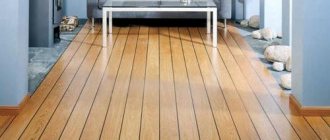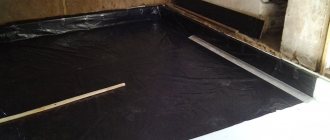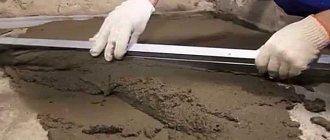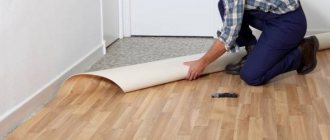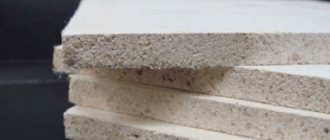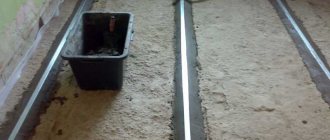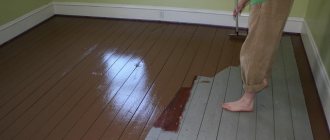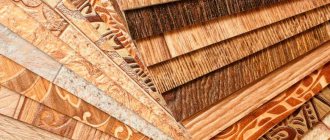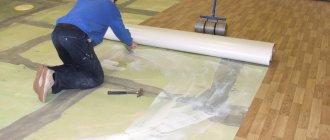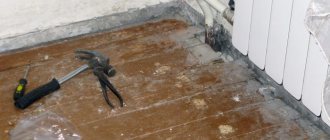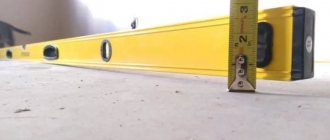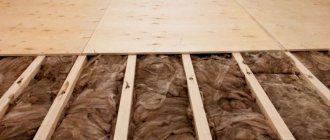Very often, floor coverings such as linoleum are used. Its use is due to its beautiful appearance, various patterns on the surface, hygiene, and ease of installation. But not everyone knows that leveling a wooden floor under linoleum is the most important stage of preparation. After all, it is necessary to prepare the base for laying linoleum especially carefully, since the elastic material, after resting, begins to follow the topography of the floor. Of course, when laying on sheet material, you will not encounter any special problems, but difficulties may arise with an old floor made of boards. In order not to make mistakes at the surface preparation stage, you need to know a few basic rules.
We analyze the condition of the floors
Before starting the installation process, it is necessary to assess the condition of the base under the linoleum and find out whether preliminary preparation of the base is necessary.
You can walk around the room at a brisk pace, jump, if the floors do not creak or wobble, then you can start working, even if the surface is not perfectly flat.
It is recommended to inspect the boards and touch areas of darkening in color with a sharp instrument. The absence of fungus, mold and rust on nails can indicate the healthy condition of the wood. Another unpleasant phenomenon of wooden coverings is insects. Boards with grooves on the surface should be replaced to prevent the rot from spreading further. In this case, it is also recommended to treat with special preparations.
It would be useful to lift several boards and evaluate their lower part, as well as the lag. If a creaking or bending occurs when walking, it can be argued that the joists cannot withstand the load, and it is necessary to place bricks or small bars for support. Sometimes squeaking occurs as a result of friction between floorboards. The problem can be solved simply by pouring talc or graphite powder into the cracks. It is also worth assessing the surface for unevenness. By sequentially performing these steps, we will get a high-quality appearance.
USEFUL INFORMATION: Adhesive for linoleum cold welding, price
Coating features
The variety of types of linoleum allows you to choose it to suit any style of your interior. The difference lies in the properties of the material and its thickness. There are three types of linoleum:
- Household is the most inexpensive and thin material, most often used in residential premises. It is easy to clean, elastic and moisture resistant. It is made on a foam base with a supporting layer of fiberglass, on which a layer of chemical foam is applied on both sides.
- Commercial - the most durable and thick, not afraid of various types of chemical and mechanical influences. It is also called industrial, but it is also suitable for residential premises. By combining multi-colored parts of this linoleum, when laying it, you can highlight special zones or simply create your own pattern.
- Semi-commercial - a middle option between household and commercial.
There are also cork, liquid and 3D linoleum. There are types that have antistatic or fire-fighting properties, as well as an insulated version. It already has at its base a material that serves as a backing made of fiber or jute on a natural basis or made of synthetic polyester.
Preparing the base surface
- You need to remove old paint from the surface of the boards and deepen the nail heads.
- If the field is level, without any distortions, you can use a plane or sanding machine.
- After removing the top part of the boards, the cracks between the floorboards and the areas where the nails are deepened must be filled with putty. After complete drying, the scraping process must be repeated.
- The untreated base of wood floors will show up on the linoleum. Leveling a wooden floor with significant unevenness and differences is carried out in other ways.
Preparation for installation
Plywood sheets cannot be used for laying flooring unless they have been previously acclimatized. The duration of the latter is determined depending on the temperature difference between the new and old environment of the building material.
If the temperature conditions have remained practically unchanged, then the acclimatization period will be at least 24 hours, with a temperature difference of 8°C - three days, in other cases - about a week.
Important! Before laying plywood, it is necessary to check the humidity level in the installation areas. If the amount of moisture exceeds the permissible standards, then you will need to take care of an additional waterproofing layer.
The main stages of leveling wooden floors under linoleum
The construction market offers materials with which you can quickly and efficiently level a wooden floor without completely or partially replacing it.
- Use of self-leveling mixture for leveling. Of course, the surface of the base will become smooth and even, but this method is not ideal. For plank floors, you need to choose a special mixture.
- To level the wooden base, sheet material is used: hardboard, OSB, plywood, fiberboard, furniture panels.
Fiberboard is an inexpensive material, the thickness of which is 2 cm. It is used only on a flat field, the main disadvantages of which are the gaps between the boards.
OSB is a structure-specific material with a thickness of 6 mm and above. It can bend under the fasteners, repeating the plane of the floor depending on the thickness. It is used on a flat surface, but with minor damage. Otherwise, there will be smooth bends on the floor plane.
Plywood is a durable material, quite expensive, but capable of properly leveling the base of the floor. The unique layered structure practically prevents sagging. For leveling, use plywood with a thickness of 10 mm.
USEFUL INFORMATION: How to cut gypsum boards: how to cut sheets at home
To get rid of unevenness, the sheets are secured with glue or a mixture of gypsum and PVA, then nailed down with nails or a special stapler. To level the surface horizontally, it is necessary to lay sheet material on logs glued to the floor. For each method of laying sheets, the seams must be carefully puttied. At the final stage, the surface is covered with drying oil.
There is no need to lay an additional layer of thermal insulation material, since the linoleum base performs these functions. Upon completion of all preparatory work, the floor is cleared of debris, vacuumed, washed and thoroughly dried. Do not forget that a gap of about 10 mm is left between the wall and plywood.
Deciding on the material and installation
Let's figure out how to lay the material so that it lasts as long as possible. Let's start with choosing a coating.
Which linoleum is better to lay on a wooden base?
It is recommended to lay such a covering in one piece, that is, the width of the room should be completely covered by the width of the material. Firstly, laying it in this way is much easier and faster, and secondly, with a two-layer flooring, the joints created, as a rule, create many problems during operation. That is why, before purchasing linoleum, you need to measure the length and width of the room and select a material of the appropriate size, taking into account a margin of 6-7 cm.
It is desirable that its thickness be at least 4 mm, this way you can avoid possible ruptures during installation and operation and extend the service life of the coating.
In many ways, the quality of the coating is determined by its manufacturing technology and class. The degree of preparation of the subfloor plays an important role. But this applies more to the installation procedure.
There are several types of linoleum for wooden floors, which differ not only in appearance, but also in structure. The choice is determined by operating conditions and requirements for its duration. When using this surface as a rough surface, you should also take into account its properties, which may change over time under the influence of external factors - temperature, humidity, etc.
Before laying linoleum on a wooden floor, you can choose the optimal type of coating. As an economical option, you can consider homogeneous models consisting of a single layer. However, they are not practical and quickly lose their appearance. Therefore, it is preferable to choose heterogeneous ones for installation on a natural surface.
Another factor determining your choice should be its variety. They come in the following types:
- PVC based. For better thermal insulation, it is best to lay linoleum on a wooden floor with a backing;
- Foamy. Consists of 4 layers, retains heat as much as possible. Disadvantage – low level of elasticity;
- Fabric. Fabric material is used as a base with a top protective coating applied. Characterized by the highest levels of flexibility;
- Alkyd. Resins with mineral additives are used for production. Disadvantage: formation of cracks;
In addition to performance qualities, the appearance of the material should also be taken into account. When deciding which linoleum is best to lay on a wooden floor, pay attention to its texture, pattern and size.
Advice
If the subfloor has a flat surface with a sufficiently high degree of mechanical strength and thermal insulation, installation can be done without a substrate. As an alternative, models with a jute or similar base are considered.
After purchasing the material, the question naturally arises not only of how to lay linoleum on a wooden floor, but also how to lay it correctly.
Summarizing
Each method has certain advantages and disadvantages, so you need to look at the situation. However, when choosing a material for leveling the floor surface, you should understand that saving will cost more. If the floor covering can be changed in the future, then the base must be done efficiently the first time. Using the recommendations given and weighing the pros and cons of each method, you can make the right choice and correctly level the base for linoleum, obtaining excellent results for many years.
Kinds
When building a room from scratch, the choice of flooring is made in advance. In a private house, the floor is usually warm, smooth and reliable, so any linoleum is chosen, and no underlay is needed here. It is also not necessary if they want to lay linoleum on top of an existing one, if the latter is in good condition. But when the floor is subject to repair or the task of sound and heat insulation is set, the underlay will help solve these problems. As a rule, this is required in post-war houses with wooden floors, barrack-type houses, Khrushchev-era buildings and private buildings.
For soundproofing
For sound insulation, you can choose a cork backing. This is perhaps the most versatile option, although expensive. The environmentally friendly backing, pressed from tree bark, gives softness, but when exposed to mechanical loads it deforms, leaving dents. Therefore it should be more dense. You can place it in a room where bulky and heavy furniture is not used. The option with a combined substrate will also reduce the amount of transmitted noise. It consists of wool, flax and jute. It is dense and rigid enough for a coating such as linoleum, and therefore fits very well under it.
The foam version can also be used; it is less environmentally friendly, but much cheaper than the others. It is produced from porous polymers, the basis of which is isolon, or penoizol. In addition, a thicker version of the backing for soft linoleum will not work, it will tear. With frequent walking, its pores stick together and over time, “paths” are formed in those places where linoleum is most often stepped on. To get rid of these troubles, a thin layer of plywood or fiberboard is nailed or screwed on top of the substrate.
For insulation
In addition to sound insulation, floor insulation is often required. It should be noted that the wooden floor itself is warm. But there are objects located above the arch of the building, on the ground floor, with a damp basement, or simply in the joints of external slabs or brickwork there are fistulas.
In these cases, there is always a draft under the floor. In addition to cork and combined substrates, which are also heat insulators, they use material made from flax fibers, which is rolled on special machines under high temperatures. This option protects the surface from drafts and also provides ventilation between the base of the floor and the linoleum, which prevents the accumulation of moisture inside.
The jute backing does not get wet, but absorbs moisture into itself, gradually getting rid of it. These options are impregnated with a fire retardant, which prevents the wood from rotting and protects against fungus. The foam material insulates the floor well and protects the space from drafts. But you need to take into account that over time it wears out. In addition, it does not allow moisture to pass through. In combination with waterproof linoleum, accidental water ingress into the joint does not bode well.
Video description
DIY wood putty.
Preparing plywood for puttying
It’s easy to prepare a concrete surface for puttying: clean it of debris, widen all the cracks, remove dust, apply a primer, and dry it. Proper preparation of a wood floor is much more difficult.
Sequencing:
- Soak the base well with drying oil. The liquid should be heated to 60° C, then applied with a brush or roller.
- Dry the treated surface with a hair dryer.
- Repeat the procedure several times.
To check the floor's readiness for applying putty, you need to spill a little water on it. If it begins to form drops, the treatment can be completed. It is important to pay special attention to the outer parts of the material. Otherwise, if moisture penetrates, they will become ruffled and eventually delaminate.
Advice! A water-repellent effect can also be obtained by impregnating plywood sheets with PVA glue.
Drying oil applied to plywood penetrates deeply into the structure of the material and forms a water-repellent film Source stroy-podskazka.ru
Padding
Plywood laid on the floor must be primed. Unlike impregnations aimed at preventing rotting, soil helps improve the quality of putty. After application, it significantly increases the adhesive properties of the surface. In addition, the primer prevents excessive penetration of putty compounds into the wood.
Priming must be carried out only with specialized products intended for finishing wood. Such compositions necessarily contain antiseptic components. They are applied with a roller or brush. The drying time of the surface depends on the external temperature and the level of humidity inside the room. It usually takes up to six hours to dry the treated base.
Attention! You can putty a plywood floor only after the soil has completely dried.
Before you putty the plywood, it must be cleaned of any contaminants and primed Source dekorator-s.ru
Puttying
Putty is applied to plywood panels in the same way as on a concrete base. To do this you will need the following tools: a spatula, a rule. It is important to pay special attention to the joints. The optimal thickness of the putty layer is 2-3 mm.
If any particles remain on the base after the material has dried, they must be removed with sandpaper. But such problems can be prevented by first passing the solution through a nylon or fine sieve. When the surface is completely dry, further finishing is allowed.
Applying putty to plywood is carried out according to the same principle as to concrete or brick Source stroiremdoma.ru
